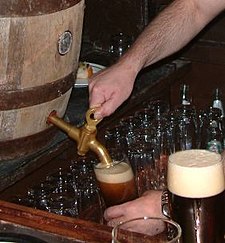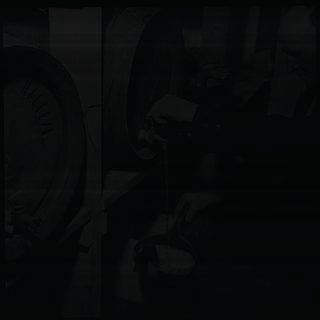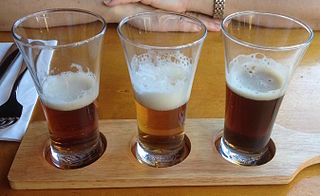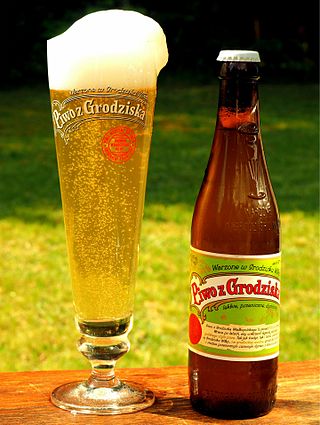
Smoked beer (German : Rauchbier) is a type of beer with a distinctive smoke flavour imparted by using malted barley dried over an open flame. [1]

Smoked beer (German : Rauchbier) is a type of beer with a distinctive smoke flavour imparted by using malted barley dried over an open flame. [1]
Drying malt over an open flame in a smoke kiln may impart a smoky character to the malt. This character may carry over to beers brewed with the smoked malt. Before the modern era, drying malted barley in direct sunlight was used in addition to drying over flames. Even though hot air kiln drying of malt, using indirect heat, did not enter into widespread usage until the industrial era, the method was known as early as the first century BC. Also, there have been various methods over the years of preparing cereal grains for brewing,[ citation needed ] including making beer from bread, [2] so smoked beer was not universal.
Beginning in the 18th century, hot air kiln drying of malt became progressively more common and, by the mid-19th century, had become the near-universal method for drying malted grain. Since the hot air kiln method prevents any smoke from coming into contact with wet malt, a smoky flavour is not imparted to the grain, nor to the subsequent beer. As a result, smoke flavour in beer became less and less common, and eventually disappeared almost entirely from the brewing world.

Certain breweries maintained the smoked beer tradition by continuing to use malt which had been dried over open flames. The malt is dried over fires made from beechwood logs. The malt and fermenting beer are stored under the pub and brewery in a part of the catacombs of Bamberg, a maze of tunnels under the city built from the 11th century onward, which have a very stable moisture and temperature. In former times, ice was used to cool the fermenting beer tank room, the Lagerkeller. This ice was locally harvested above ground in the winter, although when the winter was too mild, ice was imported from as far away as Finland or Sweden. The beer is then filtered to clarify it and remove yeast remnants, and put into oaken vats. Two brewpubs in Bamberg, Germany, Schlenkerla and Spezial, have continued this type of smoked beer production for more than a century. [3] [4] Several varieties of Rauchbier ("smoked beer" in German) are produced by these companies. Both are still in operation today, alongside seven other breweries in the same town. Since the rauchbier tradition was continuously preserved in Bamberg, the beer style is now marketed as Bamberg Rauchbier.
Due to the popularity of craft beer in recent years, smoke-flavoured industrially-produced malts became available, and so the style has been attempted worldwide, including in its heartland of Franconia and Bamberg. Schlenkerla and Spezial, however, use a traditional, elaborate way of smoke malting. In 2017 Slow Food included these two Rauchbiere in their Ark of Taste. [5]
The Brewers Association distinguishes three variations of Bamberg-style Rauchbier: Helles , Märzen , and Bock . [6] Each is brewed according to the underlying style, but with smoked malts replacing some or all of the mash bill.

Grodziskie or Grätzer are similar, traditional smoked beers from Poland, but made from wheat and highly carbonated, and with a perhaps older history, although they saw a period of no production in the late 1990s. [7] [8] [9] [10] [11] [12]
Grodziskie traditionally contain 2.7–3.7% alcohol by volume with little to no hop flavor or aroma, and medium-low to medium bitterness. [6] Typical coloration is straw to gold. [6]

Beer is one of the oldest alcoholic drinks in the world, the most widely consumed, and the third most popular drink after water and tea. Beer is produced by the brewing and fermentation of starches from cereal grains—most commonly malted barley, although wheat, maize (corn), rice, and oats are also used. The fermentation of the starch sugars in the wort produces ethanol and carbonation in the beer. Most modern beer is brewed with hops, which add bitterness and other flavours and act as a natural preservative and stabilising agent. Other flavouring agents, such as gruit, herbs, or fruits, may be included or used instead of hops. In commercial brewing, natural carbonation is often replaced with forced carbonation.

Mild ale is a type of ale. Modern milds are mostly dark-coloured, with an alcohol by volume (ABV) of 3% to 3.6%, although there are lighter-hued as well as stronger milds, reaching 6% abv and higher. Mild originated in Britain in the 17th century or earlier, and originally meant a young ale, as opposed to a "stale" aged or old ale.
Adnams is a regional brewery founded in 1872 in Southwold, Suffolk, England, by George and Ernest Adnams. It produces cask ale and bottled beers. Annual production is around 85,000 barrels.

Pale ale is a golden to amber coloured beer style brewed with pale malt. The term first appeared in England around 1703 for beers made from malts dried with high-carbon coke, which resulted in a lighter colour than other beers popular at that time. Different brewing practices and hop quantities have resulted in a range of tastes and strengths within the pale ale family.

Pale lager is a pale-to-golden lager beer with a well-attenuated body and a varying degree of noble hop bitterness.

Schlenkerla is a historic brewpub in Bamberg, Franconia, Germany, renowned for its smoked Aecht Schlenkerla Rauchbier.

India pale ale (IPA) is a hoppy beer style within the broader category of pale ale.

Beer is a major part of German culture. Only water, hops, and malt are permitted as ingredients, and beers not exclusively using barley-malt, such as wheat beer, must be top-fermented.

Beer in Norway has a long history, stretching back more than a millennium. Until some 200 years ago, most farms where it was possible to grow grain south of the Arctic Circle, brewed their own beer. From the early 20th century brewing was industrialized and home brewing was restricted. Significant consolidation in the brewing sector reduced the number of major breweries to just a handful. With the exception of the farmhouse ales, most beer styles brewed in Norway trace their ancestry to central Europe.

Beer styles differentiate and categorise beers by colour, flavour, strength, ingredients, production method, recipe, history, or origin.

Mash ingredients, mash bill, mashbill, or grain bill are the materials that brewers use to produce the wort that they then ferment into alcohol. Mashing is the act of creating and extracting fermentable and non-fermentable sugars and flavor components from grain by steeping it in hot water, and then letting it rest at specific temperature ranges to activate naturally occurring enzymes in the grain that convert starches to sugars. The sugars separate from the mash ingredients, and then yeast in the brewing process converts them to alcohol and other fermentation products.

The Malt Shovel Brewery is an Australian brewery owned by Lion, a subsidiary of the Japanese conglomerate Kirin. It is located in Camperdown, New South Wales. Malt Shovel is best known for its James Squire range of beers. The beer is named after the convict turned Australia's first brewer James Squire, who also went on to grow Australia's first hops and is said to have created Australia's first commercial brewery.

Alvinne is a small brewery in the hamlet of Moen near the Belgian city of Zwevegem, founded in 2002.

Captain Lawrence Brewing Company is a craft brewery located in Elmsford, New York. The brewery is owned and run by head brewer Scott Vaccaro. Vaccaro, a homebrewer since 1995, trained in brewing science at UC Davis.

Lager is a type of beer brewed and conditioned at low temperature. Lagers can be pale, amber, or dark. Pale lager is the most widely consumed and commercially available style of beer. The term "lager" comes from the German word for "storage", as the beer was stored before drinking, traditionally in the same cool caves in which it was fermented.

Beer in Scotland is mostly produced by breweries in the central Lowlands, which also contain the main centres of population. Edinburgh and Alloa in particular became noted for the export of beer around the world in the 19th century.

Most beer sold in France is pilsner lager, mass-produced by major breweries which control over 90% of the market, although there are also traditional beer styles, such as top-fermented Bière de Garde, and a number of microbreweries.

Grodziskie is a historical beer style from Poland made from oak-smoked wheat malt with a clear, light golden color, high carbonation, low alcohol content, low to moderate levels of hop bitterness, and a strong smoke flavor and aroma. The taste is light and crisp, with primary flavors coming from the smoked malt, the high mineral content of the water, and the strain of yeast used to ferment it. It was nicknamed "Polish Champagne" because of its high carbonation levels and valued as a high-quality beer for special occasions.

Porter is a style of beer that was developed in London, England in the early 18th century. It is well-hopped and dark in appearance owing to the use of brown malt. The name is believed to have originated from its popularity with porters.

A barrel-aged beer is a beer that has been aged for a period of time in a wooden barrel. Typically, these barrels once housed bourbon, whisky, wine, or, to a lesser extent, brandy, sherry, or port. There is a particular tradition of barrel ageing beer in Belgium, notably of lambic beers. The first bourbon barrel-aged beers were produced in the United States in the early 1990s.